In the realm of real estate, old buildings possess an undeniable charm. The worn wooden floors, the vintage architecture, and the rich history woven into their walls evoke a sense of nostalgia and character that many find irresistible. However, beneath the surface allure, lies a potential predicament – housing disrepair. This article delves into the common problems faced in old houses and addresses the question of whether it is unhealthy to reside in one.
The Allure and Challenges of Old Houses
Old houses have a distinct appeal, but with age comes a myriad of issues that can affect their habitability. These challenges often arise due to wear and tear, inadequate maintenance, or the usage of outdated construction materials. Here are some common problems encountered in aging structures:
Structural Integrity
Old buildings may suffer from compromised structural integrity, primarily due to the natural settling of foundations over time. Cracked walls, sagging roofs, and uneven floors are telltale signs of such problems. Addressing these issues promptly is crucial to prevent further deterioration and ensure occupant safety.
Dampness and Moisture
Poor waterproofing and aging plumbing systems can contribute to the accumulation of dampness and moisture within old houses. This can lead to mould growth, which not only affects the aesthetics of the building but also poses potential health risks. Individuals with respiratory conditions, such as asthma, may experience worsened symptoms in such environments.
Electrical and Wiring Concerns
Outdated electrical systems, inadequate wiring, and obsolete fuse boxes are common issues in old houses. These concerns increase the risk of electrical hazards, such as electrical shocks or fires. Proper assessment and modernization of electrical installations are necessary to ensure the safety of occupants.
Plumbing Problems
Old plumbing systems are prone to leaks, blockages, and corroded pipes. These issues can cause water damage, affect water quality, and disrupt daily routines. Timely repairs or upgrades are vital to prevent further inconvenience and maintain a healthy living environment.
Inadequate Insulation
Old houses often lack sufficient insulation, which can result in poor energy efficiency. Inefficient insulation not only leads to discomfort during extreme weather conditions but also drives up energy bills. Upgrading insulation can enhance thermal comfort and reduce energy consumption, benefiting both residents and the environment.
Is it Unhealthy to Live in an Old House?
The health implications of living in an old house depend on the specific conditions and extent of disrepair. While some old houses may pose health risks, many can be made safe and habitable through proper maintenance and renovations. Here are some factors to consider:
Air Quality
Dampness, mould, and poor ventilation can compromise indoor air quality in old houses. Exposure to mould spores and other airborne pollutants can trigger allergies, respiratory issues, and other health problems. It is essential to address these concerns by improving ventilation, repairing leaks, and conducting mould remediation, if necessary.
Lead Paint and Asbestos
Older buildings may contain lead-based paint or asbestos, both of which pose health risks when disturbed. Lead exposure can harm the neurological development of children, while asbestos fibers can cause respiratory diseases, including lung cancer and mesothelioma. Professional assessment and abatement are crucial if these hazardous materials are present.
Pest Infestations
Aging structures may provide entry points for pests such as rodents, insects, or termites. These infestations can lead to property damage and increase the risk of disease transmission. Prompt pest control measures, along with regular inspections, can help mitigate these problems.
Structural Hazards
Severely deteriorated buildings with significant structural issues can pose immediate risks to occupants’ safety. Collapsing walls, ceilings, or roofs are extreme scenarios that necessitate immediate evacuation and professional intervention. Regular inspections and proactive repairs can prevent such hazards.
Making a Housing Disrepair Claim
If you find yourself residing in an old building that is plagued with significant disrepair issues, you may have the option to make a housing disrepair claim. This legal recourse allows tenants to seek compensation or repairs from their landlords or property owners. Here are some essential steps to consider when pursuing a housing disrepair claim:
Document and Report the Disrepair
Start by documenting the specific issues and disrepair present in your living space. Take photographs, videos, and detailed notes that clearly highlight the problems. This evidence will serve as crucial support for your claim. Next, report the disrepair to your landlord or property management company, preferably in writing. Keep copies of all correspondence for future reference.
Seek Professional Guidance
Consulting with us at National Claims will provide you with valuable guidance regarding your legal rights and options. We will assess the severity of the disrepair, offer guidance on the strength of your claim, and help navigate the claims process.
Communicate with Your Landlord
Maintain open and consistent communication with your landlord or property owner throughout the process. Provide them with an opportunity to address the disrepair by arranging necessary repairs or renovations. It is essential to keep records of all communication, including dates, times, and details of discussions or agreements made.
Gather Supporting Evidence
Continue to document any further developments or deterioration of the disrepair. Keep records of any inconvenience caused, such as disruption to your daily life or additional expenses incurred due to the disrepair. Collect any relevant medical records or reports if you or your household members have suffered health issues as a result of the disrepair.

How Much Compensation For Damp And Mould UK?
To find out how much compensation you can receive for your housing disrepair, it is best to fill out one of our claims forms that can be found throughout our website.
Conclusion
Living in an old building with housing disrepair issues can be challenging, but it does not necessarily mean an unhealthy living environment. By recognising and addressing common problems such as structural integrity, dampness, electrical concerns, plumbing issues, and inadequate insulation, you can improve the habitability of your home.
While some old houses may pose health risks, thorough maintenance, regular inspections, and necessary repairs can mitigate these concerns. Additionally, it is important to be aware of your rights as a tenant and consider making a housing disrepair claim if your landlord fails to address the issues adequately.
Remember, an old house has its own unique charm and character, and with proper care and attention, it can provide a safe and comfortable home for you and your loved ones. Embrace the journey of preserving the history and beauty of your dwelling, while ensuring a healthy and livable environment for all.
Contact us today to start your claim and to gather more information regarding housing disrepair claims.
Click below to see why we are one of the most trusted claims management companies in the UK.





